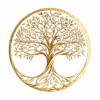Explore the Slavic death and rebirth archetype. These gods and goddesses taught that death cleared space for growth and new beginnings.

Archetype Overview
The Slavic Death and Rebirth Archetype: An Eternal Dance of Light and Shadow
In the old Slavic world, death never meant an end. It whispered of change. Life and death moved in circles, not lines. Gods rose, fell, and rose again. Seasons faded, then bloomed anew. The land slept in frost, only to awaken in fire. Morana, the goddess of death and winter, brought stillness and sorrow. But her fall gave rise to Yarilo, the god of spring and passion. Their story was not one of enemies but of balance.
Each god held a season, from Kolyada’s winter songs to Kupala’s summer flames. Each spirit marked a turn in the great wheel. Kostroma and Kupalnitsa, born of sorrow and joy, vanished and returned like the rivers thawing in spring. Even radiant and eternal, Dazhbog sank each night to rise again. In Slavic myth, the line between death and life was blurred. One always gave way to the other—forever locked in an endless, sacred dance.
Deities’ Summary Pages
Archetype Characteristics
The Eternal Cycle: Key Traits of the Slavic Death and Rebirth Archetype
Death came softly in Slavic myth—never cruel, never final. It moved like the wind. It arrived with winter’s hush and left with spring’s first thaw. Rebirth followed close behind, like footsteps in the snow. This was not a single tale but a rhythm. A pulse that beat through every myth, every god, every season.
The Slavic Death and Rebirth Archetype lived in change. It spoke through fading light and growing shadow. It held silence in one hand and song in the other. Time didn’t move forward—it circled. Everything that died returned. Everything that bloomed would fall. The people felt it in their bones. In the snow melting beneath the sun. In the fire that came after frost.
This archetype didn’t fear death. It welcomed it. Death cleared the way. It made room for new life. The Slavs saw the world as a great wheel. Turning. Always turning. No end. No true beginning. Only the dance between dark and light. Cold and warm. Sorrow and joy. Death and rebirth.
Deities’ Detailed Write-Ups
Archetype Role In Myths
The Story Beneath the Snow: Slavic Death and Rebirth Archetype in Slavic Myth
Slavic myths didn’t rush. They moved like seasons—slow, sure, and full of meaning. At their heart stood a pattern: something must end so something may begin. This was the role of the Death and Rebirth Archetype. It shaped the story behind every tale. It gave myths their rise and fall, their sorrow and their bloom.
Nothing in these stories stayed still. Love turned to loss. Life faded into silence. But silence never lasted. Something always stirred beneath the cold. This cycle gave weight to every myth. It made each ending feel holy. Each return felt earned, not given. The archetype created tension and release. Stillness, then movement. Grief, then joy.
It reminded listeners that time was a circle. That every fall held a promise. Even in the darkest tale, spring waited just beyond the frost.
Significance of Archetype in Antiquity
Through Frost and Flame: The Meaning Behind Slavic Death and Rebirth Archetype
The land shaped the myth. Harsh winters froze the world in silence. Spring broke that silence with light. The people watched. They felt the earth sleep and wake. And from this rhythm, a truth was born—nothing died forever. This idea was breathed through every story. It gave the people hope.
The Slavic Death and Rebirth Archetype carried deep meaning. It offered comfort in grief. It gave purpose to pain. Loss became part of life, not its end. Even sorrow had a place. It cleared space for joy to return. The people saw their own lives in the cycle. Their crops. Their kin. Their hearts.
This archetype taught patience. Trust in the turning world. Darkness would pass. Light would rise again. Myths echoed what the people already knew: all things come, go, and return. Always.
Archetype Applications In Modern Settings
The Old Cycle, New Eyes: Slavic Death and Rebirth Archetype Today
The world changed, but the stories stayed. Their roots still reached through time. The Slavic Death and Rebirth Archetype now speaks in quiet ways. It lives in healing. In letting go. In starting again.
People today feel loss, just as before. They face endings—jobs, love, dreams. But like the old myths, they rise. They begin again. Spring still follows winter, in life as in story. The cycle still turns.
Modern life moves fast. But this archetype reminds us to pause. To trust the stillness. To believe in the return. Death, in any form, is not failure. It’s the soil for new growth. The myth teaches this—then and now.

























